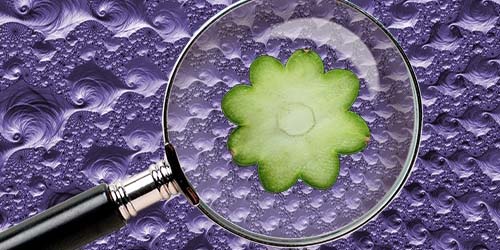
Tiny amounts of shrooms, LSD or magic truffles. Microdosing has a growing reputation. In this series of articles, we explore which natural psychedelics you can use for microdosing, and what the benefits and possible risks of microdosing are. This time we are flying to North and South America to cut the Peyote and San Pedro cacti that occur there into really tiny pieces. These cacti have been in use for millennia for religious and spiritual purposes. These cacti contain mescaline; this is a substance that can bring you into contact with animal guides, ancestors and give you temporarily all kinds of traits that we could really use nowadays.
This is part three from a series about microdosing with different psychedelic smart drugs.
- Part 1: Magic Truffles
- Part 2: Ayahuasca
- Part 3: Peyote & San Pedro Cacti
- Part 4: LSD & LSA
What is Mescaline?
By nature, certain cacti contain a substance that can get you out of your head. Mescaline (ofr 3,4,5-Trimethoxyphenethylamine). This powerful psychoactive substance can also be synthesized (prepared in the lab) but you can also obtain it from several cacti. Mescaline is one of the hallucinogens which you can find in free nature.
It is mainly the Peyote (Lophophora williamsii), Peruvian torch (Echinopsis/Trichocereus peruviana) and San Pedro (Echinopsis/Trichocereus pachanoi) cacti which contain a reasonable amount of mescaline [2,4,5]. The Peyote occurs more frequently in the dry areas of North America, whereas San Pedro and Peruvian Torch thrive at height in the Andes mountain range in South America. The round-shaped and prickle-free Peyote is a slow grower whereas the elongated San Pedro really grows quickly for a cactus. Incidentally, mescaline is not the only psychoactive substance in these spiky plants. But little research has been done to establish which substances are responsible in each cactus type for providing it with its individual psychedelic experience.
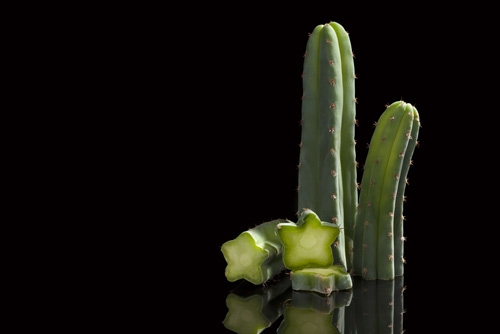
San Pedro Cactus
How Does Mescaline Work?
With mescaline, you cannot get off your head to such an extent as with the so-called ‘classic psychedelics, DMT, LSD and psilocybin (the active substance in shrooms and magic truffles). Indeed, if you look at it under a microscope, the substance is slightly different from the other three substances.
The active substance in the cacti comes under a different chemical denominator (that of the phenethylamines) than e.g. those in shrooms, ayahuasca (tryptamines) and LSD (ergolines). But thanks to research, we know that all these substances ‘stick’ to the serotonin receptor (5-HT) in the brain, especially to the subtype 2A. For that reason we call them serotonergic psychedelics.
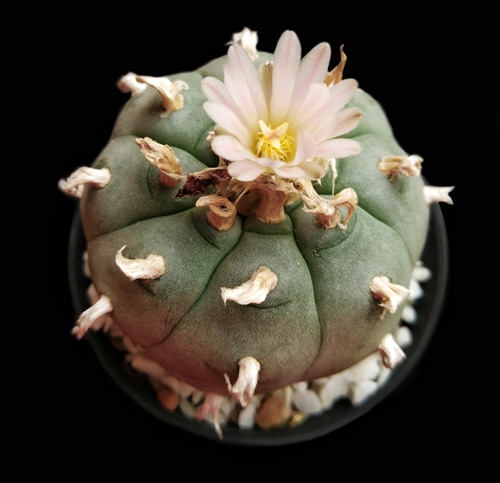
Peyote Cactus
Serotonin is an important neurotransmitter which influences our feelings and how we process information. Mescaline was one of the first psychedelics for which it was shown that it could have actual therapeutic value. In the 1960’s, a team of researchers investigated [1] whether it was possible for mescaline to solve complex issues. Volunteers were each given 200 mg mescaline and were asked whether they wanted to think about a work problem. Some of the volunteers worked for months on architectural designs, experiments with space probes and mathematical problems. The result? Virtually all participants solved the problem or found a new way in which to look at it. You’re probably asking yourself how that happened. According to the scientists, some of the properties of mescaline are:
- Reduced inhibitions and fear (of failure).
- Ability to deal with ideas more fluently
- The ability to view problems from a broader perspective
- Enhanced empathy with other people
- Enhanced fantasy and imaginary powers
- Enhanced feeling for the ‘eureka!’ moment [1]
Effects of Microdosing
Microdosing with tiny amounts of psychedelics is done to acquire some positive traits. And do so without hallucinating. Detailed investigation into the actual effects is currently ongoing. If you microdose with peyote, peruvian torch or San Pedro, the following effects may occur:
- Elevated mood
- Mental acuity / Enhanced focus
- Self-reflection
- Reduced craving for addictive substances
- Enhanced creativity
- Improved empathy
- You become more extroverted and sociable
- Increased energy and motivation [2]
Preparation of Peyote and San Pedro
Why should you eat a cactus? You’d think that the prickles would mean it wasn’t easy! We discussed some of the good ways in which to prepare them in the blog about san pedro and peyote cacti. For example, you can brew tea with it or powder the cactus. We didn’t discuss the latter method before and it could be ideal, not only for taking mescaline but for getting all the other substances in the cactus as well. Not all substances dissolve in water.
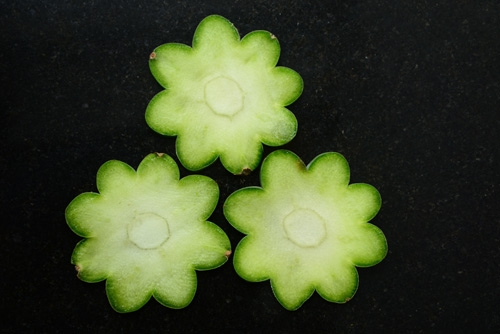
San Pedro Cactus Slices
Disclaimer: The preparation of cacti that contain mescaline in whatever quantity whatsoever is an illegal practice. Even if the keeping or cultivating of the cacti is legal in the country where you live. Dutch Headshop accepts no liability whatsoever for violation of the applicable law.
Making Cactus Powder
Before you start to make cactus powder, you should know that preparing a cactus is a laborious and time-consuming task. It varies per cactus, but expect to be busy for several hours.
The peyote is somewhat easier to prepare because normally speaking it has no prickles. In the case of the torch or the san pedro, remove the woody core. This doesn’t contain much mescaline anyway and it’s also difficult to process. In all these cacti, you find the most active substance just under the leathery skin. You do, of course, need to take some care with the torches and pedros. But once you have removed the prickles and the outer skin, you are left with enough to finely grind the cactus. When removing the skin, be sure to take away as little as possible of the brown matter under the skin. This part is where most of the mescaline is located. Firstly, cut the cactus into as many small pieces as you can. Dry the pieces for several days between two sheets of kitchen towel in a warm, dry place. For the grinding process, use a large grinder or a coffee mill. Grind the dried pieces into powder. You can then put the powder in capsules, using a capsule filling machine It can also be done by hand but a machine will save you a lot of fiddly work and time and they are not that expensive.
The big advantage of this method is that you can fill a big batch of capsules which will allow you to experiment with the dosage and avoid the bitter taste of the cacti. Thanks to the grinding and mixing, you have now homogenized the composition. Each capsule ought to contain the same amount of active substance.
Professional tip: Please do not eat or powder any cactus seeds. These contain far too little mescaline (if any at all). Using the seeds and growing kits from our web shop, you can easily cultivate cacti yourself. Nice to have at home, but for a trip or for microdosing the cultivation of a cactus is really only for long-term thinking. Would you like to discover what the effects of peyote are at the weekend. If so, then opt for a ready-made Peyote or San Pedro. Brilliant to have at hand indoors, and you can use it as soon as it’s delivered.
Microdosing with Peyote or San Pedro - How much do you need?
You don’t need very much for peyote or san pedro microdosing. That’s because microdosing with cacti which contain mescaline is particularly awkward. One of the reasons is that the amount of mescaline contained varies from one cactus to another. And we’re not referring to different cactus species. One peyote may contain (a lot) more mescaline than another which is growing next to it.
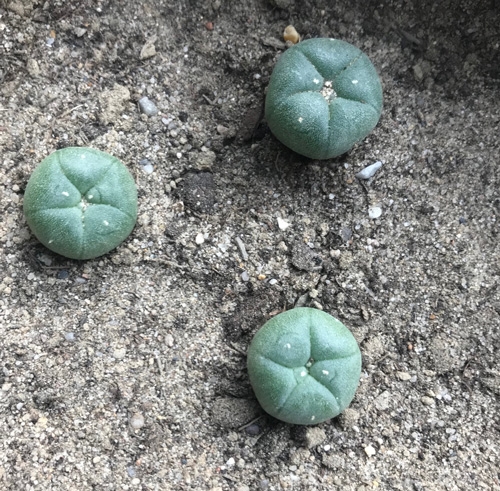
Peyote Cactus
Just as with any psychedelic, a trip stands or falls on the dosage. So, if you don’t know exactly how much active substance a cactus contains, it’s extremely awkward to establish a good dosage for microdosing. In terms of microdosing from cacti, you are in a grey area between a mild trip in which you definitely experience psychedelic visual effects and the placebo effect where you just haven’t taken enough.
In the table below [2,3,4] we have set out some figures for you. Please use this figures as a guideline only, because dosing from cacti is (as already mentioned) extremely awkward.
|
. |
Microdosing |
Mild Trip |
Intense Trip |
|
Fresh Peyote |
2.5 grams |
50-100 grams |
200 grams+ |
|
Dried Peyote |
0.5 grams* |
10-20 grams |
40 grams+ |
|
Fresh San Pedro |
5 grams |
100-200 grams |
400 grams+ |
|
Dried San Pedro |
0.5 grams* |
10-20 grams |
40 grams+ |
|
Mescaline Sulfate |
10 mg |
200-400 mg |
800 mg+ |
|
Mescaline Hydrochloride |
9 mg |
180-360 mg |
700 mg+ |
|
Freebase Mescaline |
5 mg |
100-300 mg |
600 mg+ |
With the powder method, you can get approximately half a gram in one capsule. So, 1 capsule of peyote powder should be enough for one microdose.
Microdosing Schedule
Have you organised it and are starting to microdose? In that case, consider the following points:
- Mescaline works for longer (up to 24 hours) than psilocybin in Magic Truffles and Shrooms (up to 6-7 hours). It’s therefore more difficult to choose the right moment for microdosing with cacti. In any case, start early in the day so you are able to sleep properly that night. [3]
- In the same way as any psychedelic that affects the serotonin receptors, you soon build up a tolerance to mescaline. This means that the chance of addiction is very slight and that there is no point in taking peyote or san pedro for a long time. You therefore need to allow a few days interval between microdoses.
- The tolerance is interchangeable. That means that it makes no difference which psychedelics you use. After using peyote or san pedro for a few days in a row you have the same tolerance for other shrooms, LSD, LSA, DMT and 2C-B.
There are two microdosing schedules in common use - one by James Fadiman and the other by Paul Stamets.
| . |
Fadiman |
Stamets |
|
Day 1 |
Dosing |
Dosing |
|
Day 2 |
Not dosing / transition day |
Dosing |
|
Day 3 |
Not dosing / normal day |
Dosing |
|
Day 4 |
Dosing |
Dosing |
|
Day 5 |
Not dosing / transition day |
Dosing |
|
Day 6 |
Not dosing / normal day |
Not dosing |
|
Day 7 |
Repeat |
Not dosing |
|
Day 8 |
x |
Repeat |
The protocol or schedule of Dr. James Fadiman is the oldest and most commonly used. You take a dose every other day. Mycologist Paul Stamets’ microdosing protocol takes into account the latest research into how psychedelics affect the human body. It’s mainly used for stacking tiny amounts of shrooms, lion’s mane and vitamin B3 for additional therapeutic purposes [6].
Safety First
You mustn’t microdose with psychedelics for too long. Definitely not for more than a couple of months in a row. This is because there are indications that long-term use of psychedelics can be bad for your heart. It’s difficult to dose mescaline from cacti so you should definitely not drive if you are experimenting with peyote or san pedro.
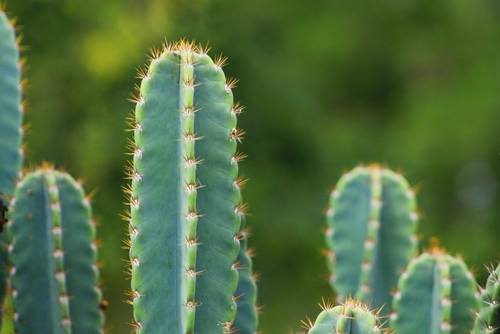
San Pedro Cactus
Conclusion: Is Microdosing with Peyote or San Pedro a Good idea?
As you have read in this article, dosing for a microdose from mescaline cacti can merge seamlessly into a mild trip. Therefore it might happen that with a couple of grammes you notice mild hallucinations such as patterns, figures and geometric forms. Especially with closed eyes. With microdosing you are aiming for the less noticeable effects of psychedelics such as enhanced focus, creativity and mental acuity. Microdosing with dried peyote and san pedro in capsules is more measurable but you probably won’t get the right dosage first off and the chance of either a trip or just a placebo effect is distinctly real.
San pedro, peruvian torch and peyote cacti contain highly variable amounts of active substances but the effects last longer than with shrooms and magic truffles. The effects of cacti are also slightly different. On the other hand, research was already being done in the 1960s into the effects of (larger doses of) mescaline. That makes microdosing with cacti that naturally contain this substance interesting but difficult and challenging.
Want to know more about these particular cacti? If so, then read this article.
Sources:
- [1] Harman, W.W., McKim, R.H., Mogar, R.E., Fadiman, J., Stolaroff, M.J. (1966). Psychedelic agents in creative problem-solving: a pilot study. Psychological Reports, 19(1):211-27. doi:10.2466/pr0.1966.19.1.211.
- [2] The Ultimate Guide to Microdosing Mescaline. The Third Wave. 2018. https://thethirdwave.co/microdosing/mescaline
- [3] Psychonaut Wiki | Mescaline: https://psychonautwiki.org/wiki/Mescaline
- [4] Erowid Mescaline Vault. https://www.erowid.org/chemicals/mescaline/mescaline.shtml
- [5] Erowid Books Online | Pihkal. https://erowid.org/library/books_online/pihkal/pihkal096.shtml
- [6] Microdosing Psilocybin Mushrooms with the Stamets Stack. Dow, Kyle. 19 Nov 2019. https://thethirdwave.co/microdosing-psilocybin-mushrooms-stamets-stack